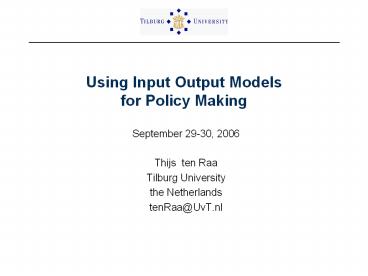Using Input Output Models for Policy Making - PowerPoint PPT Presentation
1 / 7
Title:
Using Input Output Models for Policy Making
Description:
Then how construct input-output coefficients? IO Analysis without the A-matrix ... TFP = FP EC = SR TT EC, where EC = -(du/dt)/u. The Canadian economy -0.1. 0.1 ... – PowerPoint PPT presentation
Number of Views:55
Avg rating:3.0/5.0
Title: Using Input Output Models for Policy Making
1
Using Input Output Models for Policy Making
- September 29-30, 2006
- Thijs ten Raa
- Tilburg University
- the Netherlands
- tenRaa_at_UvT.nl
2
Use and Make Matrices
- uij represents the amount of commodity i used by
industry j - vij represents the amount of commodity i made by
industry j - vij - uij is the net output of commodity i
produced by industry j - Summing over industries Gross Domestic Product
(GDP) - Summing over commodities Gross Domestic Income
(GDI) - Leontief Balans narodnogo khoziaistva SSSR
- metodologicheskii razbor rabotii TSSU
- Planovoe Khoziaistvo 12, 254-58 (1925)
3
Input-output coefficients
- U AV e
- Regress the inputs on the outputs
- Estimate the coefficients, including their
confidence intervals - Need at least as many observations (firms or
industries) as commodities - Published use and make tables have less
industries than commodities - Then how construct input-output coefficients?
4
IO Analysis without the A-matrix
- Productivity analysis
- Find potential output preserving the composition
of final demand
5
The Lagrange multipliers
- Tell by how much potential output increases if
you add a unit to the factor constraint - Hence they are the factor productivities
- Add over factors (Total) Frontier Productivity
FP - Its growth rate can be seen to be equal to the
residual between potential output growth and
factor input growth - It can be decomposed in industry Solow Residuals
plus the terms of trade effect FP SR TT - Total Factor Productivity growth TFP is the
residual between actual output growth and factor
input growth - TFP FP EC SR TT EC, where EC
-(du/dt)/u
6
The Canadian economy
1962-1974 1974-1981 1981-1991
SR 1.7 -1.3 -0.3
TT 0.7 0.5 3.8
EC -0.6 0.9 -3.7
TFP 1.8 0.1 -0.1
7
Further IO Analysis without the A-matrix
- Impact of free trade Comparative advantage and
adjustment - Efficiency analysis of firms, industries and the
national economy - Measurement of competition and its effect on
performance - Neoclassical economists argue it is positive,
Schumpeter argues it is negative. The evidence
is insignificant. - IO Analysis decomposes departures from
competition in labor rent and capital rent.
Opposite effects! - ten Raa The Economics of Input-Output Analysis
- Cambridge University Press 2005

